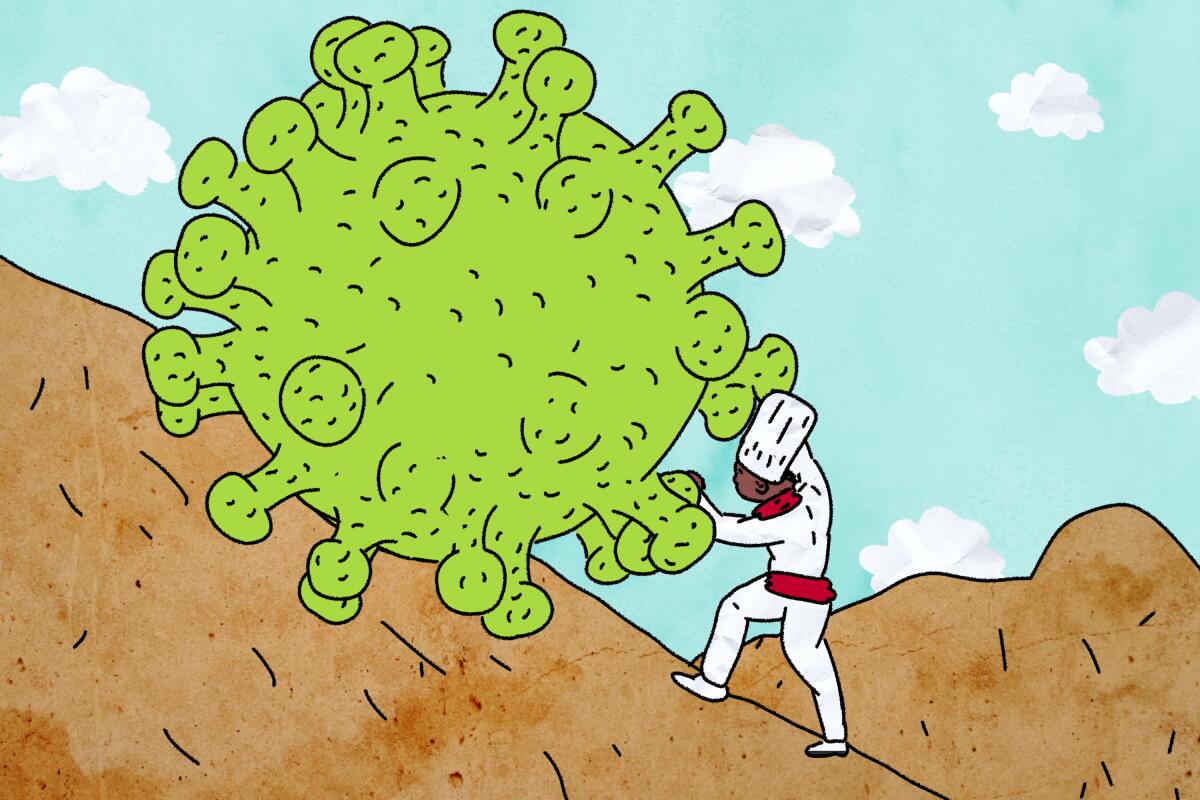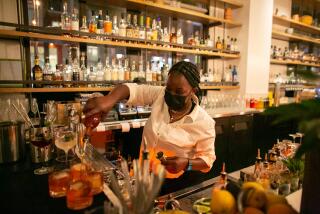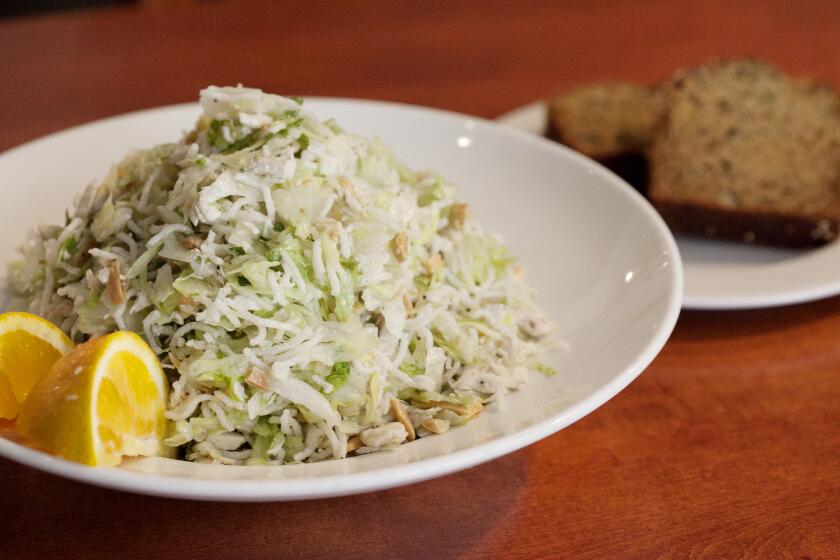Omicron poses new threats to restaurants and bars

- Share via
After a lull in reported COVID-19 cases in the fall and the hope that things might be approaching something resembling normal, restaurants are, again, reporting disruptions and steep drops in revenue.
According to a new study from the Independent Restaurant Coalition, 58% of restaurants and bars nationwide lost more than half their revenue under the Omicron surge. The fast-moving variant, which can infect people who have been vaccinated and boosted, is coming on the heels of a disastrous two years and is responsible for new challenges and staffing setbacks.
Restaurateurs are finding new — and old — ways to pivot, this time without shutdowns or further dining guidelines from county officials. Some are suing their insurance providers over compensation for COVID losses. Some are continuing through the latest surge with indoor service, while others are flipping back to takeout-only models because of test shortages and delays in results. There is no clear path and little direction.
“Restaurants were getting really busy, things were looking really good, people were feeling comfortable dining inside,” said Caroline Styne, a co-owner of the Lucques Group and a board member of the Independent Restaurant Coalition, which funded the January survey of nearly 1,200 U.S. restaurants. “Even with Delta and all the mitigations we were doing to work through that, we were feeling really optimistic — and then with Omicron, it’s really brought us back to 2020.”
One of her restaurants lost close to $1 million in 2020, she says, and it remained in the hole in 2021. Styne and the restaurant-advocacy group are calling upon the federal government to replenish the Restaurant Revitalization Fund; more than 177,000 restaurants did not receive the federal grant money, and even those who were able to secure a grant are still struggling.
“So many restaurateurs have gone into personal debt trying to hold on through all of this,” Styne said. “I keep saying I feel like we’re all in a big boat that’s taking on water and we’re throwing cups out, but somebody keeps throwing gallons back in.”
Justin Pichetrungsi revitalized his parents’ Sherman Oaks business in 2020 when indoor dining closed, taking over an alleyway that runs along the side of Anajak Thai Cuisine and launching new dining programs such as weekly pop-up Thai Taco Tuesday and an omakase menu. They brought back indoor dining in the fall of 2021, but after Thanksgiving the chef-owner saw Omicron numbers rising and, fearing a spike from more holiday travel, decided he would temporarily pause it. The move, he said, is costing his family restaurant roughly 50% of its revenue.
“[Dine-in] was really busy, right up until the very last day,” Pichetrungsi said. “It was as packed as it was going to get, and it was like shooting myself right in the foot.”
While Anajak’s patio can seat 30 to 40 guests, Pichetrungsi worried that even flipping to outdoor-only dining wouldn’t be enough to protect his staff. Customers still had to enter the dining room to use the restroom, to browse and select wine, and to speak to employees. His parents and his aunt help run the restaurant, and the chef decided the risk of exposing his family and staff was growing too high.
Diners want a level of consistency, he said, and he acknowledges the pivots are confusing. Most customers have been supportive and sympathetic about the decision, though he notes he’s received multiple emails from customers who were angry that their reservations would need to be rescheduled. The plan, for now, is to wait until case numbers decrease, possibly until March, then resume outdoor a la carte dining, and then bring back the omakase, followed by Thai Taco Tuesday.
Keizo Shimamoto is no stranger to running takeout service, although he said it breaks his heart to serve the ramen he took years to perfect in a to-go container, its parts separated and the noodles not cooked to the exact doneness of a dine-in experience. The chef soft-opened his long-awaited Ramen Shack in San Juan Capistrano in September, and then rolled out a full schedule and menu only weeks before the Omicron wave.
In addition to the routine concern of keeping staff and customers healthy through the pandemic, Shimamoto said the increased delays in receiving test results have provided new hurdles to operating a restaurant.
“In November we all got tested right away — same day or the next morning — and we got results back right away,” he said. “This time it’s taking two to three days to schedule a test, sometimes up to a week depending on what website you go to. They’re all booked, and the results are taking another three, four, five days. I took a COVID test yesterday. If this comes back positive three days from now, then I have to schedule another test and wait a couple days, then wait another four or five days to get positive or negative, and it delays it even more.”
The delays nearly shut down Ramen Shack last week. In November Shimamoto began making his own noodles in-house; after his daughter was exposed to COVID-19 at school, the chef and his family quarantined at home. Shimamoto, the only one on staff who can make the fresh noodles, waited multiple days as his noodle stock dwindled — if he hadn’t tested negative and gone in to replenish the supply, Ramen Shack would have been unable to open.
Since the start of the Omicron surge, the chef estimates 15% to 20% of his staff members have tested positive. About 50% of them have shown symptoms (when they do, they stay home until they test negative). With staffing so lean across the industry, even one worker out sick can make the difference for a restaurant’s bottom line. Lacking staff for both lunch and dinner, Ramen Shack paused its lunch service — but as soon as one of its cooks who’d been sidelined tested negative, they returned to work and reinstated lunch.
It’s been a roller coaster for Ramen Shack, like so many other restaurants.
“My shop did close on [Jan. 11],” he said. “My staff was able to open yesterday and today doing minimal hours, but it’s definitely taken a hit. Front-of-house staff have been sidelined for the last week and a half and aren’t making money. I see it as well as the owner: It’s definitely a stressful time, but we’re taking it one day at a time.”
More to Read
Eat your way across L.A.
Get our weekly Tasting Notes newsletter for reviews, news and more.
You may occasionally receive promotional content from the Los Angeles Times.











